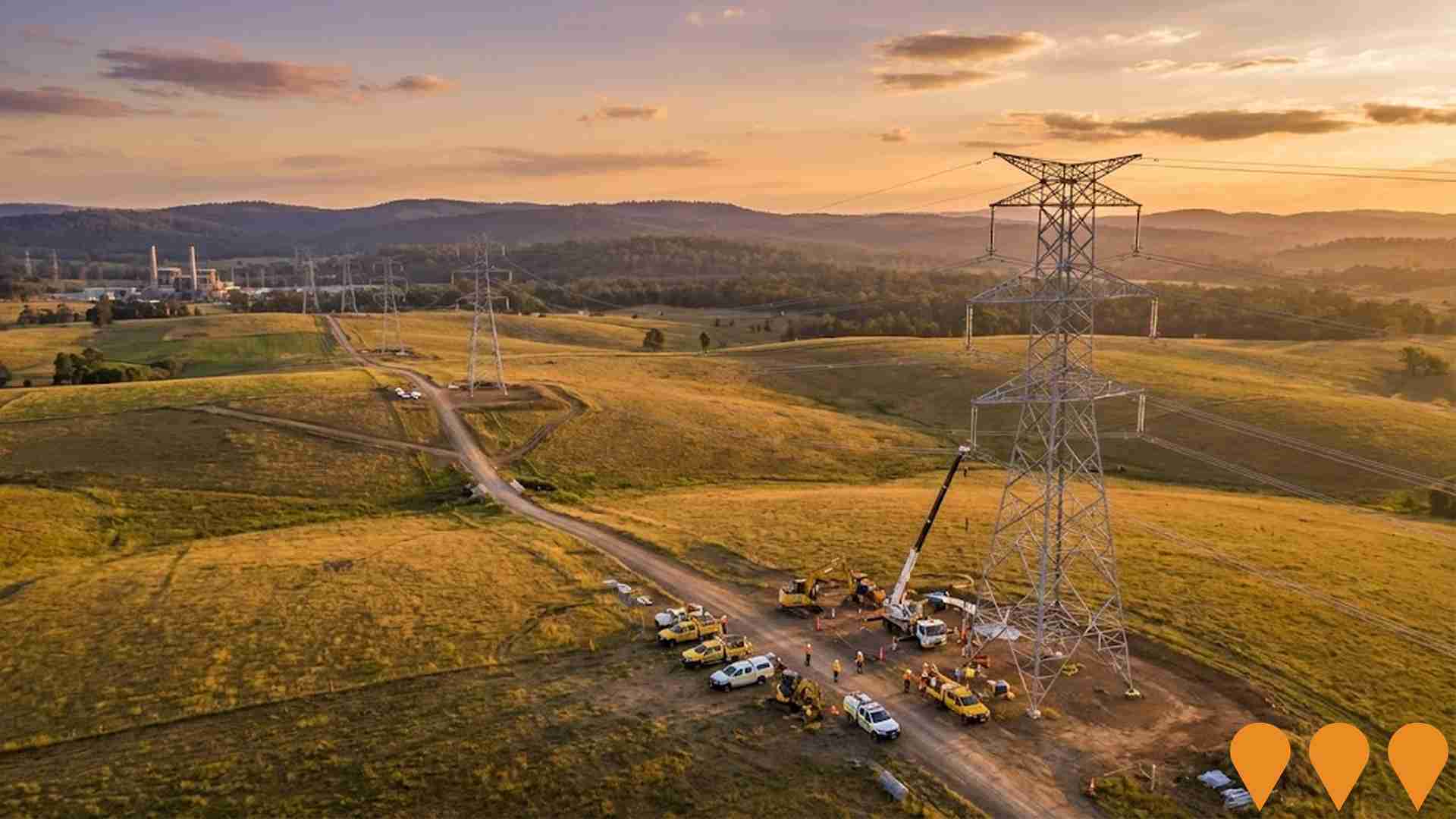Chart Color Schemes
est. as @ -- *
ABS ERP | -- people | --
2021 Census | -- people
Sales Activity
Curious about local property values? Filter the chart to assess the volume and appreciation (including resales) trends and regional comparisons, or scroll to the map below view this information at an individual property level.
Find a Recent Sale
Sales Detail
Population
Fraser is positioned among the lower quartile of areas assessed nationally for population growth based on AreaSearch's assessment of recent, and medium term trends
Fraser's population was around 2,072 as of August 2025. This showed a decrease of 54 people since the 2021 Census, which reported a population of 2,126 people. The change was inferred from ABS's estimated resident population of 2,070 in June 2024 and an additional 11 validated new addresses since the Census date. This resulted in a density ratio of 835 persons per square kilometer. Population growth was primarily driven by overseas migration, contributing approximately 81.6% of overall population gains during recent periods.
AreaSearch adopted ABS/Geoscience Australia projections for each SA2 area, released in 2024 with 2022 as the base year. For areas not covered and years post-2032, age group growth rates from ACT Government's SA2 area projections were used, also based on 2022. Projections indicated a decline of 362 persons by 2041. However, specific age cohorts like the 85 and over group were projected to increase by 28 people.
Frequently Asked Questions - Population
Development
AreaSearch assessment of residential development drivers sees a low level of activity in Fraser, placing the area among the bottom 25% of areas assessed nationally
Fraser has seen approximately four new homes approved annually over the past five financial years, totalling twenty-one homes. As of FY26, zero approvals have been recorded so far. Between FY21 and FY25, an average of 1.4 people moved to the area per dwelling built yearly. However, this figure decreased to -6.8 people per dwelling over the past two financial years. New homes are being constructed at an average expected cost of $213,000, below regional levels, indicating more affordable housing options for buyers.
In FY26, $276,000 in commercial development approvals have been recorded, suggesting minimal commercial development activity. Compared to the Australian Capital Territory, Fraser shows significantly reduced construction activity, 65.0% below the regional average per person. This limited new construction typically reinforces demand and pricing for existing properties, which is also under the national average, indicating the area's established nature and potential planning constraints. New building activity consists of 50.0% detached houses and 50.0% attached dwellings, reflecting a trend towards denser development to provide accessible entry options appealing to downsizers, investors, and entry-level buyers. This marks a significant change from the current housing mix, which is predominantly houses (96.0%). The estimated population count of 870 people per dwelling approval reflects Fraser's quiet, low activity development environment. Given stable or declining population projections, Fraser should experience reduced housing demand pressures, benefiting potential buyers.
With population projections showing stability or decline, Fraser should see reduced housing demand pressures, benefiting potential buyers.
Frequently Asked Questions - Development
Infrastructure
Fraser has emerging levels of nearby infrastructure activity, ranking in the 21stth percentile nationally
Changes to local infrastructure significantly impact an area's performance. AreaSearch identified one major project likely affecting this region. Key projects include Ginninderry Stage 3 - The Valley Release, Ginninderry Estate - Stages 4-7 (Strathnairn & future Macnamara), Macnamara Residential Estate, and New Northside Hospital. Below is a list of those most relevant.
Professional plan users can use the search below to filter and access additional projects.
INFRASTRUCTURE SEARCH
 Denotes AI-based impression for illustrative purposes only, not to be taken as definitive under any circumstances. Please follow links and conduct other investigations from the project's source for actual imagery. Developers and project owners wishing us to use original imagery please Contact Us and we will do so.
Denotes AI-based impression for illustrative purposes only, not to be taken as definitive under any circumstances. Please follow links and conduct other investigations from the project's source for actual imagery. Developers and project owners wishing us to use original imagery please Contact Us and we will do so.
Frequently Asked Questions - Infrastructure
New Northside Hospital (North Canberra Hospital Redevelopment)
Development of a new major tertiary hospital on the existing North Canberra Hospital campus (formerly Calvary Public Hospital). The project involves an investment of over $1 billion to construct a new state-of-the-art clinical services building, expanded emergency department, and modern inpatient facilities to replace aging infrastructure.
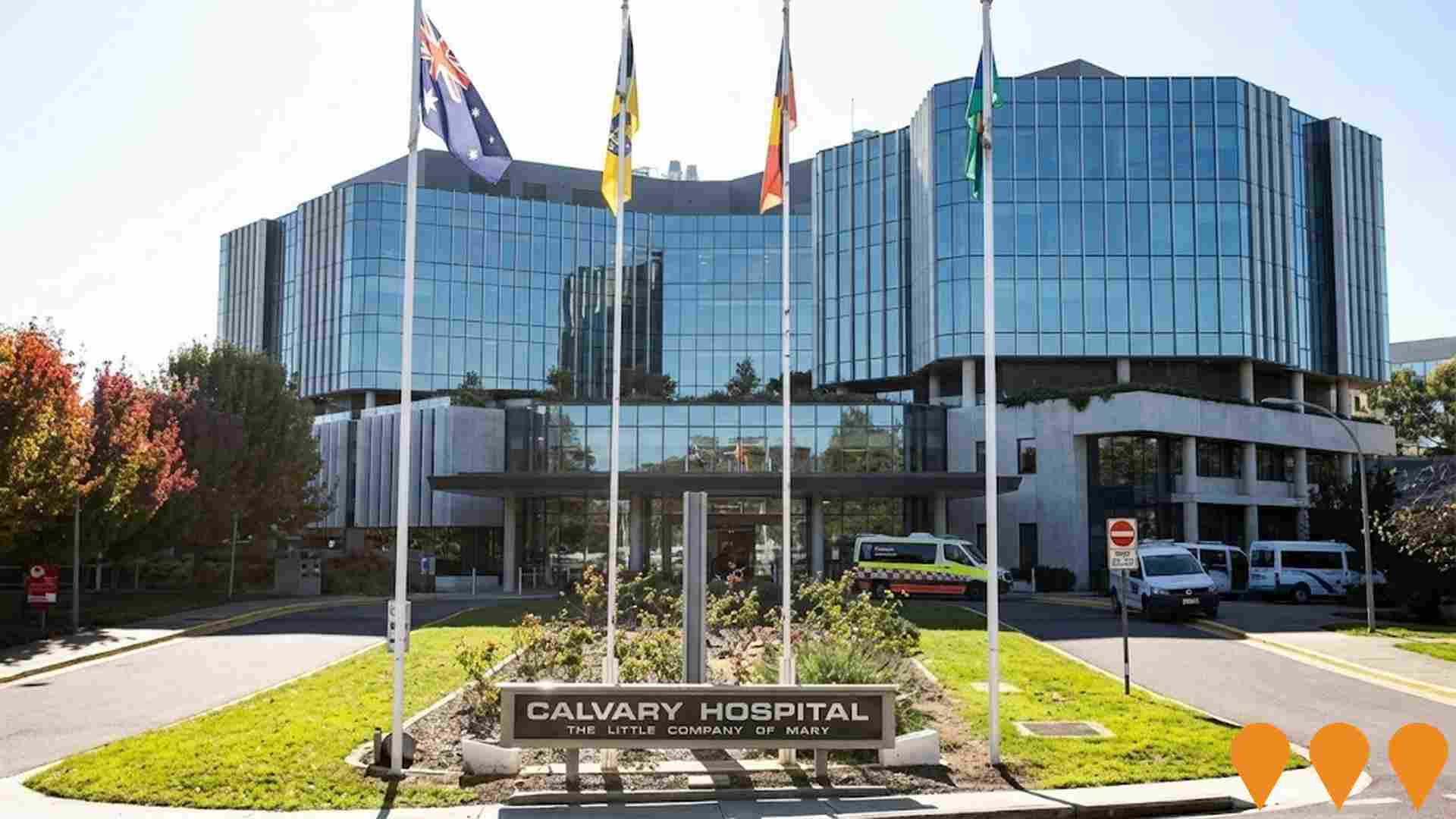
Low and Mid-Rise Housing Policy
State-wide NSW planning reforms via amendments to the State Environmental Planning Policy to enable more diverse low and mid-rise housing (dual occupancies, terraces, townhouses, manor houses and residential flat buildings up to 6 storeys) in well-located areas within 800 m of selected train, metro and light-rail stations and town centres. Stage 1 (dual occupancies in R2 zones statewide) commenced 1 July 2024. Stage 2 (mid-rise apartments, terraces and dual occupancies near stations) commenced 28 February 2025. Expected to facilitate up to 112,000 additional homes over the next five years.
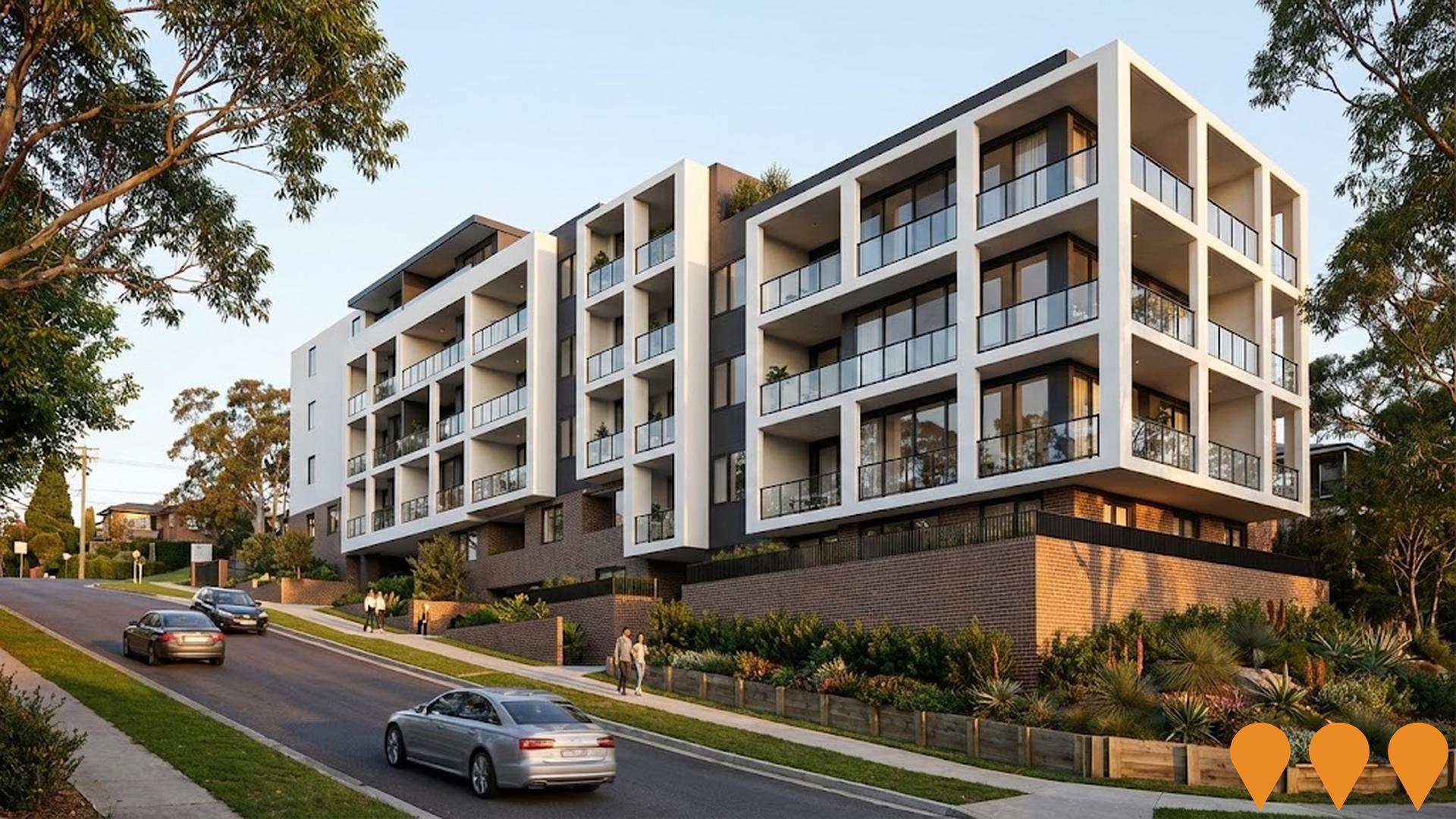
Ginninderry Estate - Stages 4-7 (Strathnairn & future Macnamara)
Canberra's largest master-planned community spanning the ACT-NSW border, delivering approximately 11,500 dwellings total, with ongoing stages immediately adjacent to and west of Dunlop.
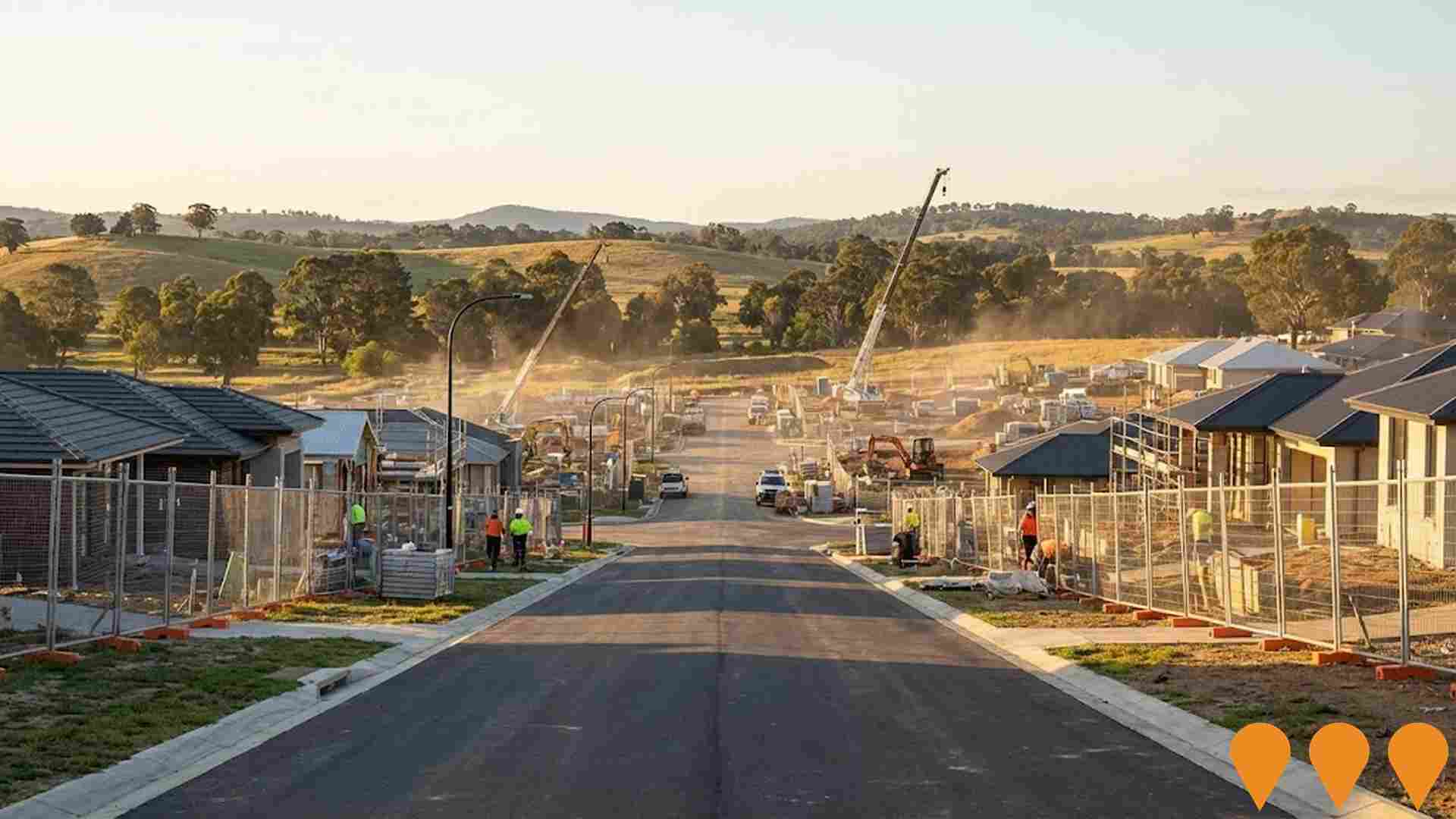
Enhanced bus and light rail corridors (Belconnen & Queanbeyan to Central Canberra)
ACT is progressing an integrated program to enhance high-frequency bus and future light rail corridors that link Belconnen and Queanbeyan with central Canberra. Light Rail Stage 2A (City to Commonwealth Park) commenced construction in early 2025 with services targeted from 2028, while planning and approvals continue for Stage 2B to Woden. The ACT Government has acknowledged and is planning upgrades for the Belconnen-to-City bus corridor as groundwork for a future east-west light rail Stage 3, and is coordinating cross-border public transport initiatives with NSW through the Queanbeyan Region Integrated Transport Plan and the ACT-NSW MoU for Regional Collaboration.
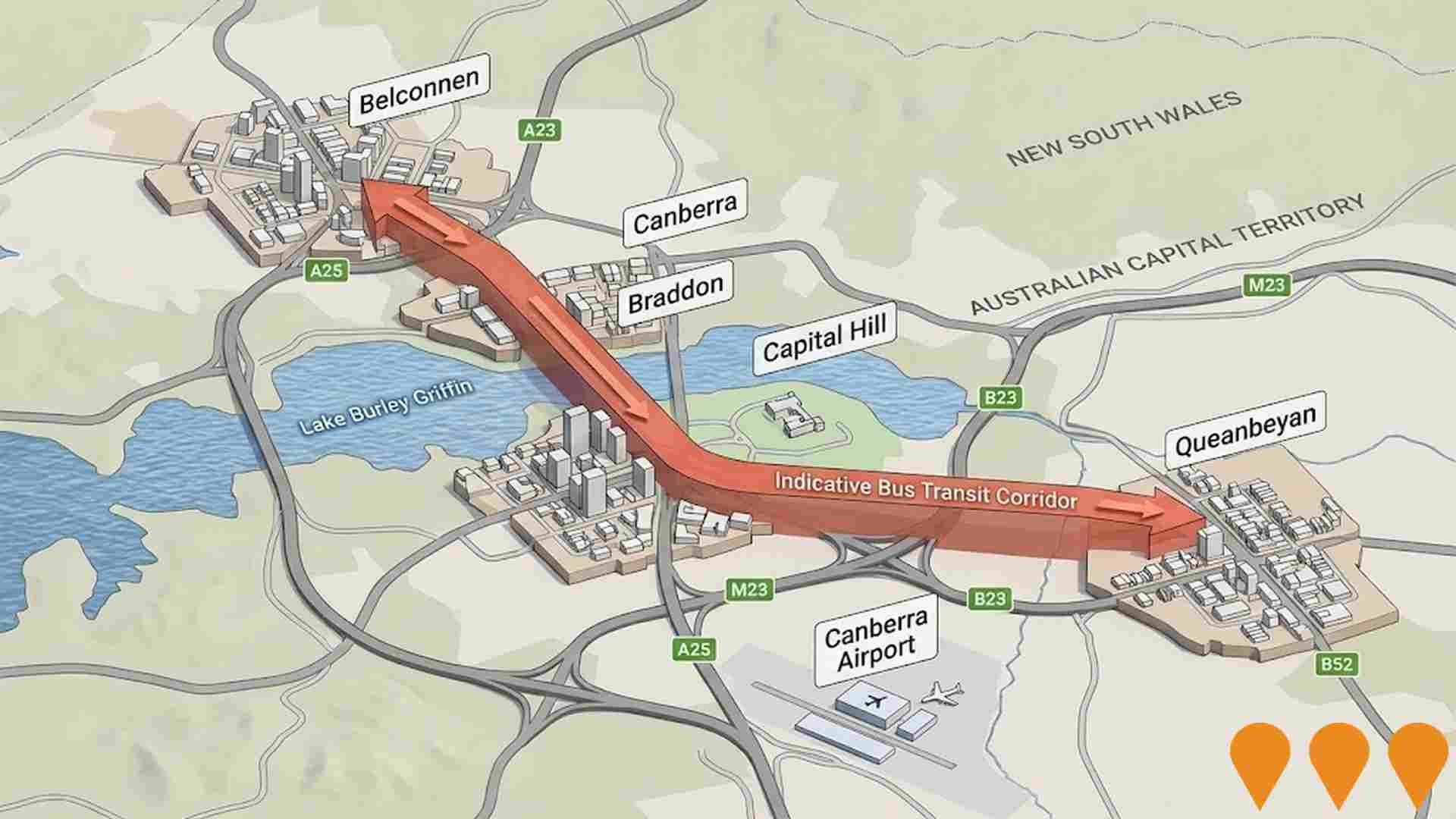
HumeLink
HumeLink is a new 500kV transmission line project connecting Wagga Wagga, Bannaby, and Maragle, spanning approximately 365 km. It includes new or upgraded infrastructure at four locations and aims to enhance the reliability and sustainability of the national electricity grid by increasing the integration of renewable energy sources such as wind and solar.
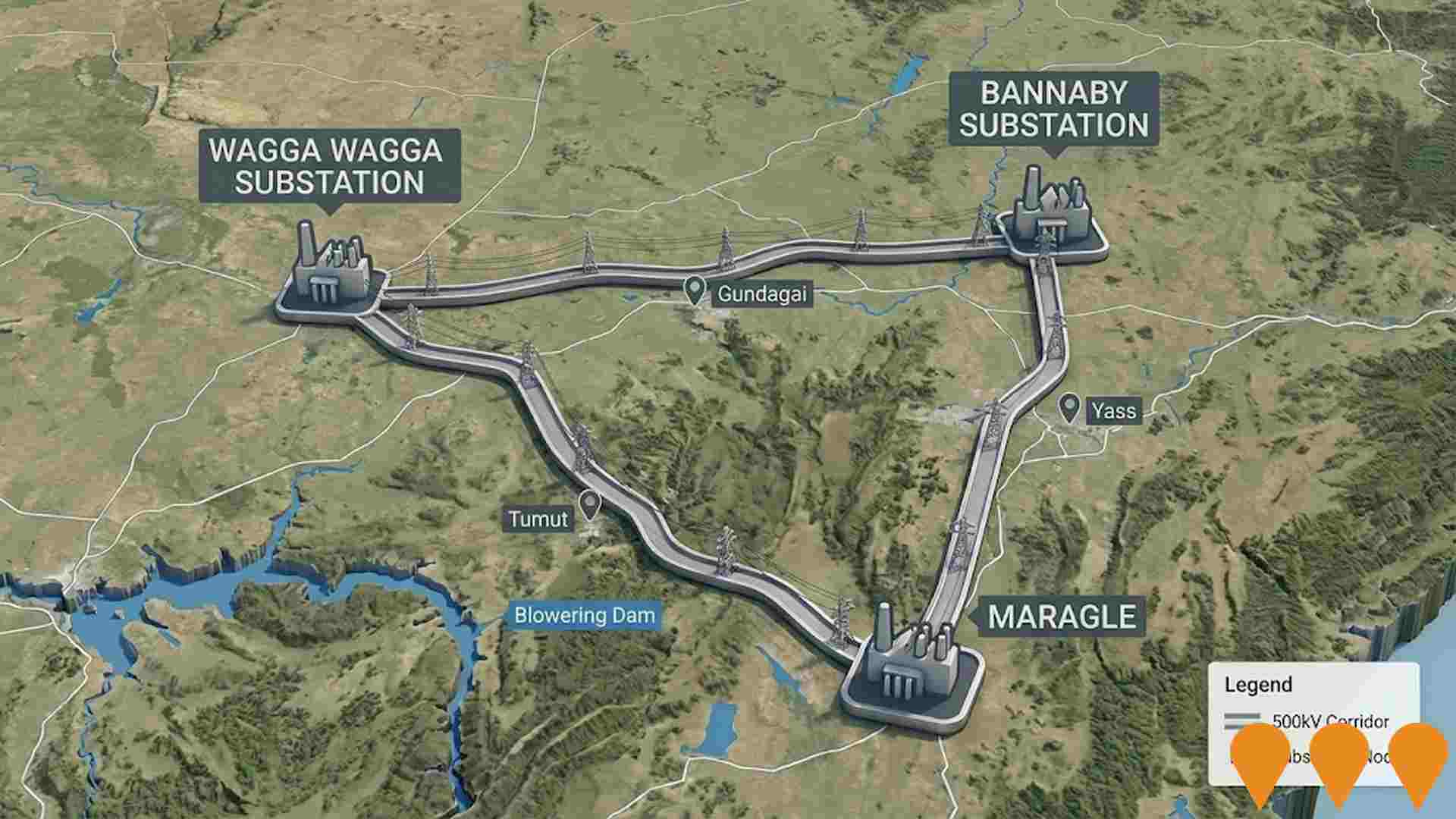
Macnamara Residential Estate
New greenfield suburb immediately north-west of Dunlop, part of the broader Ginninderry development, delivering over 1,800 homes plus local shops and schools.
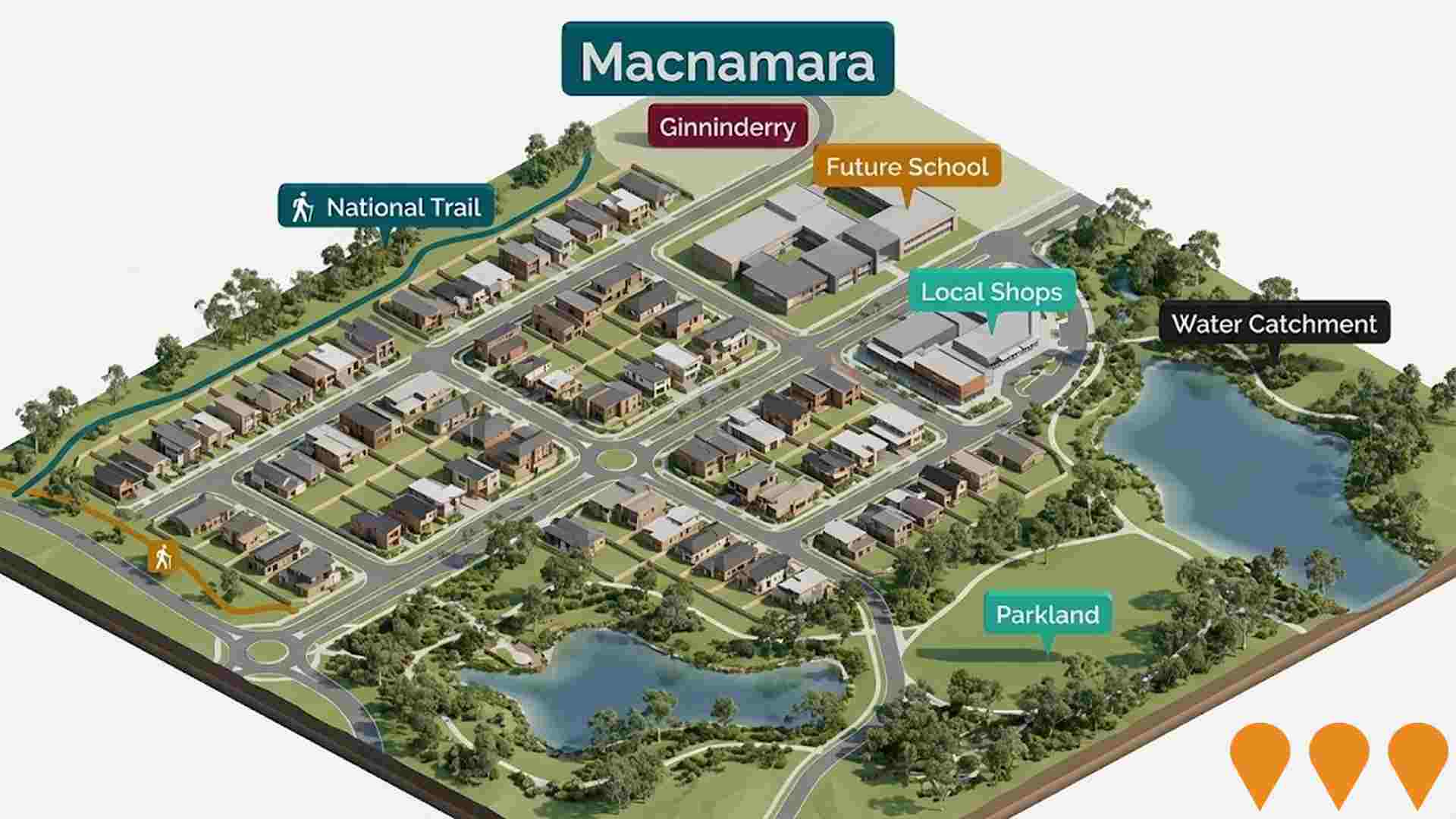
Queanbeyan Regional Integrated Transport Plan
Comprehensive transport planning initiative with 64 key actions for next 10 years. Addresses road safety, active transport connectivity, public transport availability, and future transport needs. Improved connections between Queanbeyan and ACT.
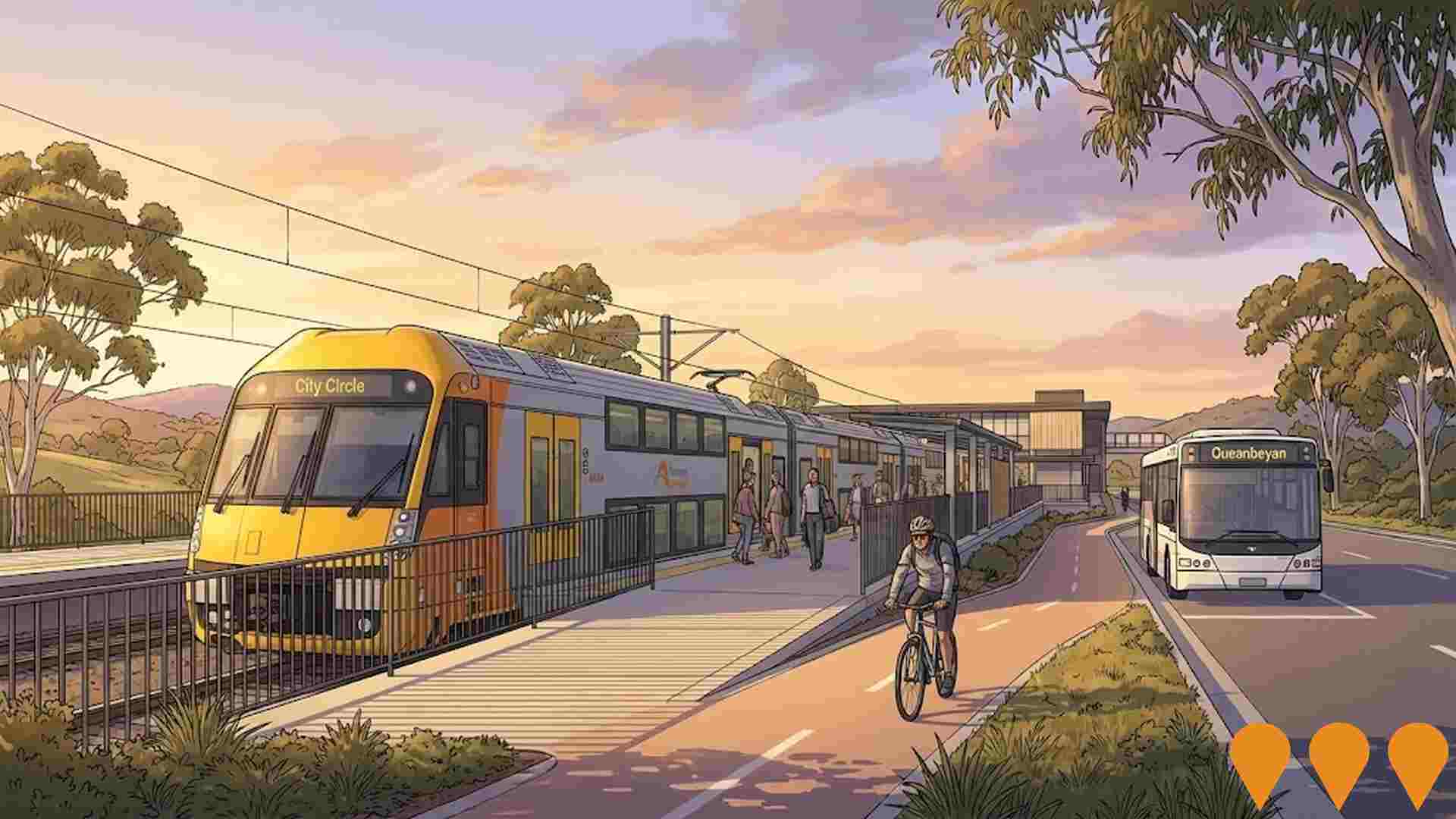
Big Canberra Battery (Williamsdale BESS)
A 250 MW / 500 MWh battery energy storage system at Williamsdale in southern Canberra, delivered by Eku Energy as Stream 1 of the ACT Government's Big Canberra Battery. Construction commenced in November 2024 with partners CPP and Tesla supplying Megapack systems. The asset will connect to Evoenergy's 132 kV network near the Williamsdale substation to provide two hours of dispatchable power, grid services and reliability for the ACT. Target operations in 2026.
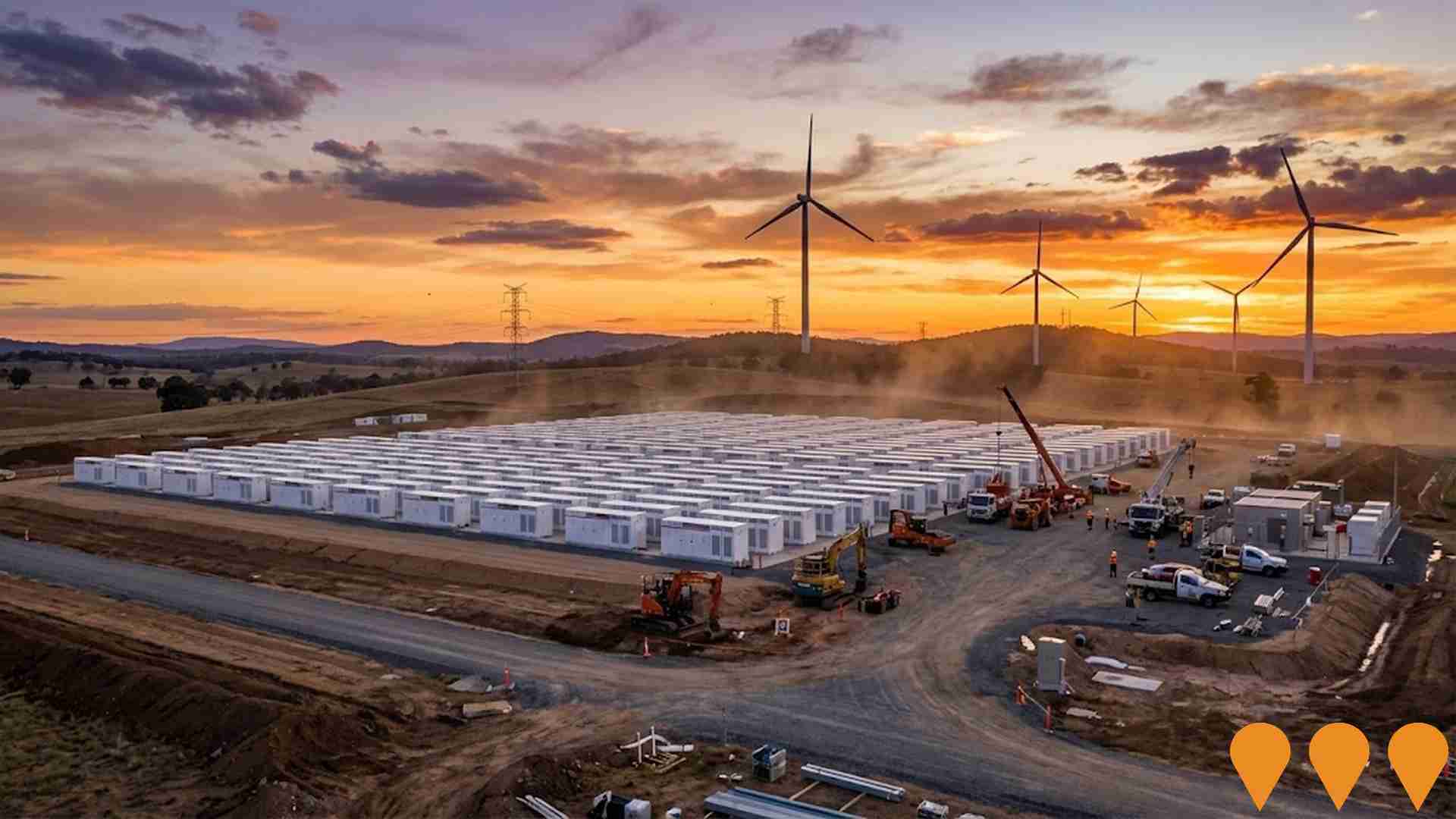
Employment
Fraser shows employment indicators that trail behind approximately 70% of regions assessed across Australia
Fraser has an educated workforce with 4.5% unemployment as of June 2025. Employment grew by 1.1% over the past year.
The unemployment rate is 1.1% higher than the Australian Capital Territory's rate of 3.4%. Workforce participation in Fraser lags at 64.1%, compared to Australian Capital Territory's 69.6%. Key industries include public administration & safety, professional & technical services, and education & training. Construction employment is notably high, at 1.6 times the regional average.
However, public administration & safety is under-represented, with only 26.7% of Fraser's workforce compared to Australian Capital Territory's 30.4%. The area offers limited local employment opportunities, as indicated by Census data. Over June 2024 to June 2025, employment increased by 1.1%, while labour force grew by 1.6%, raising the unemployment rate by 0.4 percentage points. In comparison, Australian Capital Territory saw employment growth of 1.9% and a decrease in unemployment by 0.3 percentage points. Jobs and Skills Australia's national employment forecasts from May 2025 project overall employment growth of 6.6% over five years and 13.7% over ten years. Applying these projections to Fraser's industry mix suggests local growth of approximately 6.6%% over five years and 13.3% over ten years, though this is a simplified extrapolation for illustrative purposes only.
Frequently Asked Questions - Employment
Income
The economic profile demonstrates exceptional strength, placing the area among the top 10% nationally based on comprehensive AreaSearch income analysis
AreaSearch released postcode level ATO data for financial year 2022. Fraser's median income among taxpayers was $68,310 with an average of $77,216. These figures were among the highest in Australia, compared to the Australian Capital Territory's median of $68,678 and average of $83,634. Based on Wage Price Index growth of 13.6% since financial year 2022, current estimates would be approximately $77,600 (median) and $87,717 (average) as of September 2025. According to the 2021 Census figures, household, family and personal incomes in Fraser ranked highly nationally, between the 89th and 93rd percentiles. The income distribution showed that 30.2% of individuals earned between $1,500 and $2,999, reflecting regional patterns where 34.3% fell within this range. Economic strength was evident with 43.6% of households achieving high weekly earnings exceeding $3,000, supporting elevated consumer spending. After housing costs, residents retained 89.0% of their income, indicating strong purchasing power. The area's SEIFA income ranking placed it in the 8th decile.
Frequently Asked Questions - Income
Housing
Fraser is characterized by a predominantly suburban housing profile, with above-average rates of outright home ownership
Dwelling structure in Fraser, as evaluated at the latest Census, comprised 95.8% houses and 4.2% other dwellings. In comparison, Australian Capital Territory had 69.4% houses and 30.5% other dwellings. Home ownership in Fraser was 41.1%, with mortgaged dwellings at 47.7% and rented dwellings at 11.2%. The median monthly mortgage repayment in Fraser was $2,167, higher than the Australian Capital Territory average of $2,000. The median weekly rent figure in Fraser was $450, compared to the Australian Capital Territory's $430. Nationally, Fraser's median monthly mortgage repayments were significantly higher at $2,167 versus the Australian average of $1,863, and rents were substantially above the national figure of $375.
Frequently Asked Questions - Housing
Household Composition
Fraser features high concentrations of family households, with a higher-than-average median household size
Family households account for 83.3% of all households, including 39.6% couples with children, 31.2% couples without children, and 11.6% single parent families. Non-family households constitute the remaining 16.7%, with lone person households at 14.8% and group households comprising 1.5%. The median household size is 2.9 people, which is larger than the Australian Capital Territory average of 2.5.
Frequently Asked Questions - Households
Local Schools & Education
Fraser shows strong educational performance, ranking in the upper quartile nationally when assessed across multiple qualification and achievement indicators
The area's university qualification rate is 35.6%, substantially lower than the SA4 region average of 46.8%. This presents both a challenge and an opportunity for targeted educational initiatives. Bachelor degrees are the most prevalent at 22.9%, followed by postgraduate qualifications (7.7%) and graduate diplomas (5.0%). Trade and technical skills are prominent, with 31.0% of residents aged 15+ holding vocational credentials – advanced diplomas (12.4%) and certificates (18.6%).
Educational participation is high, with 30.3% of residents currently enrolled in formal education. This includes 11.6% in primary education, 8.3% in secondary education, and 3.9% pursuing tertiary education. Fraser Primary School serves the local educational needs within Fraser, with an enrollment of 486 students as of a recent report. The school operates under typical Australian school conditions (ICSEA: 1039) and offers balanced educational opportunities. It focuses exclusively on primary education, with secondary options available in nearby areas. As an education hub, the area provides 23.5 school places per 100 residents, significantly higher than the regional average of 15.1, attracting students from surrounding communities.
Frequently Asked Questions - Education
Schools Detail
Nearby Services & Amenities
Transport
Transport servicing is high compared to other areas nationally based on assessment of service frequency, route connectivity and accessibility
Transport analysis indicates 33 active stops operating within Fraser, offering a mix of bus services. These stops are served by six distinct routes, collectively facilitating 1,542 weekly passenger trips. Transport accessibility is rated excellent, with residents typically situated 122 meters from the nearest stop.
Service frequency averages 220 trips daily across all routes, equating to approximately 46 weekly trips per individual stop.
Frequently Asked Questions - Transport
Transport Stops Detail
Health
Health performance in Fraser is lower than average with common health conditions somewhat prevalent across both younger and older age cohorts
Fraser faces significant health challenges with common health conditions prevalent across both younger and older age cohorts.
Approximately 58% of Fraser's total population (1,197 people) have private health cover. The most common medical conditions are mental health issues affecting 9.9% of residents and arthritis impacting 9.8%. 64.2% of residents declared themselves completely clear of medical ailments compared to 68.1% in the Australian Capital Territory. Fraser has a higher proportion of residents aged 65 and over at 19.2% (397 people) compared to the Australian Capital Territory's 15.3%.
Frequently Asked Questions - Health
Cultural Diversity
Fraser ranks below the Australian average when compared to other local markets across a number of language and cultural background related metrics
Fraser's cultural diversity was found to be below average, with 82.8% of its population born in Australia, 94.8% being citizens, and 91.3% speaking English only at home. Christianity is the predominant religion in Fraser, comprising 44.8% of people. However, Islam is overrepresented compared to the Australian Capital Territory average, making up 1.6% of Fraser's population versus 3.3%.
In terms of ancestry, the top three groups are English (29.7%), Australian (28.3%), and Irish (9.5%). Notably, Welsh (0.8%) and Scottish (9.0%) ethnicities are overrepresented in Fraser compared to regional averages of 0.6% and 7.4%, respectively. Samoan ethnicity is also slightly overrepresented at 0.3%.
Frequently Asked Questions - Diversity
Age
Fraser's median age exceeds the national pattern
The median age in Fraser is 41 years, which is considerably higher than the Australian Capital Territory's average of 35 years and modestly exceeds the national average of 38 years. Compared to the Australian Capital Territory average, the 65-74 cohort is notably over-represented at 11.6% in Fraser, while the 25-34 age group is under-represented at 8.4%. Post-2021 Census data shows that the 75 to 84 age group has grown from 4.6% to 6.7%, and the 45 to 54 cohort has increased from 13.5% to 14.9%. Conversely, the 65 to 74 cohort has declined from 14.2% to 11.6%. Population forecasts for 2041 indicate substantial demographic changes for Fraser. The 85+ age group is expected to grow by 153%, reaching 43 people from 16, and residents aged 65 and older will represent 100% of the anticipated population growth. Conversely, the 45 to 54 and 0 to 4 age cohorts are expected to experience population declines.
